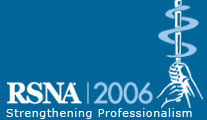
Abstract Archives of the RSNA, 2006
SSQ05-07
Dynamic Perfusion MRI versus Quantitatively and Qualitatively Assessed CT versus Perfusion SPECT: Capability for Prediction of Postoperative Lung Function in Lung Cancer Patients
Scientific Papers
Presented on November 30, 2006
Presented as part of SSQ05: Chest (MR Imaging)
Yoshiharu Ohno MD, Presenter: Nothing to Disclose
Hisanobu Koyama MD, Abstract Co-Author: Nothing to Disclose
Munenobu Nogami MD, Abstract Co-Author: Nothing to Disclose
Daisuke Takenaka MD, Abstract Co-Author: Nothing to Disclose
Sumiaki Matsumoto MD, PhD, Abstract Co-Author: Nothing to Disclose
Takeshi Yoshikawa MD, Abstract Co-Author: Nothing to Disclose
Kazuro Sugimura MD, Abstract Co-Author: Nothing to Disclose
et al, Abstract Co-Author: Nothing to Disclose
To directly compare the capability of dynamic perfusion MR imaging (perfusion MRI) for prediction of postoperative lung function in lung cancer patients with quantitatively and qualitatively assessed CT and perfusion SPECT.
150 lung cancer patients (87 men and 63 women) underwent dynamic perfusion MRI, 4-detector-row CT, perfusion SPECT, and measurements of FEV1% before and after lung resection. Dynamic perfusion MRIs were acquired with a 3D turbo field echo sequence using a 1.5T scanner. On dynamic perfusion MRI, postoperative FEV1% (poFEV1%) was predicted from semi-quantitatively assessed blood volumes within total and resected lungs. Quantitatively predicted poFEV1% using CT was determined from functional lung volumes within total and resected lungs by commercially available software. Qualitatively predicted poFEV1% using CT was determined from the number of segments of total and resected lungs. On perfusion SPECT, poFEV1% was predicted from uptakes within total and resected lungs. Then, each predicted poFEV1% was correlated with actual poFEV1%, and the limits of agreement between actual and each predicted poFEV1% were also evaluated by Bland-Altman analysis.
poFEV1%s predicted by dynamic perfusion MRI (r=0.87, p<0.0001) and quantitative CT (r=0.88, p<0.0001) had better correlation with actual poFEV1%, when compared with qualitative CT (r=0.83, p<0.0001) and SPECT (r=0.83, p<0.0001). The limits of agreement between predicted and actual poFEV1% by dynamic perfusion MRI (5.3±11.8%) and quantitative CT (5.0±11.6%) were smaller than those by qualitative CT (5.1±13.8%) and SPECT (6.8±14.4%).
Dynamic perfusion MRI can more accurately predict postoperative lung function than qualitative CT and perfusion SPECT, and is at least as valuable as quantitative CT in lung cancer patients.
Dynamic perfusion MRI has better capability for prediction of postoperative lung function than qualitative CT and perfusion SPECT, and is as valuable as quantitative CT in lung cancer patients.
Ohno, Y,
Koyama, H,
Nogami, M,
Takenaka, D,
Matsumoto, S,
Yoshikawa, T,
Sugimura, K,
et al, ,
Dynamic Perfusion MRI versus Quantitatively and Qualitatively Assessed CT versus Perfusion SPECT: Capability for Prediction of Postoperative Lung Function in Lung Cancer Patients. Radiological Society of North America 2006 Scientific Assembly and Annual Meeting, November 26 - December 1, 2006 ,Chicago IL.
http://archive.rsna.org/2006/4428465.html

